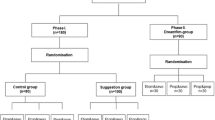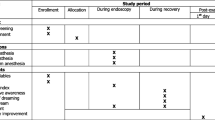Abstract
Patients frequently report having dreams during general anesthesia, and the dreams are often reported to be pleasant dreams. However, factors associated with the quality of dreams during general anesthesia have not been clarified. The aim of this study was to determine the relationships between the quality of dreams during general anesthesia and perioperative factors. This prospective observational study included patients scheduled for elective surgery under general anesthesia. Preoperative mental status was assessed by the Hospital Anxiety and Depression Scale (HADS). A postoperative interview was carried out in the operating room after recovery from general anesthesia. Dreams and awareness during general anesthesia were assessed by a modified Brice interview. The quality of dreams was classified in accordance with the patient’s own opinion as pleasant, indifferent, or unpleasant. A total of 1100 patients were included in the study, and 293 (25.4%) of the patients reported having dreams during anesthesia. Half of the patients who experienced dreams during anesthesia (50.2%, 147/293 patients) reported having a pleasant dream. Multivariate logistic regression analysis revealed that only HADS-depression score of less than 11 was related to pleasant dreams (OR: 3.3 [95% CI 1.3–10.0]).
Similar content being viewed by others
References
Leslie K. Dreaming during anesthesia. In: Mashour G, editor. Consciousness, awareness, and anesthesia. Cambridge: Cambridge University Press; 2010. p. 74–89.
Leslie K, Myles PS, Forbes A, Chan MT, Swallow SK, Short TG. Dreaming during anaesthesia in patients at high risk of awareness. Anaesthesia. 2005;60:239–44.
Schmid RL, Sandler AN, Katz J. Use and efficacy of low-dose ketamine in the management of acute postoperative pain: a review of current techniques and outcomes. Pain. 1999;82:111–25.
Leslie K, Skrzypek H, Paech MJ, Kurowski I, Whybrow T. Dreaming during anesthesia and anesthetic depth in elective surgery patients: a prospective cohort study. Anesthesiology. 2007;106:33–42.
Errando CL, Sigl JC, Robles M, Calabuig E, García J, Arocas F, Higueras R, Del Rosario E, López D, Peiró CM, Soriano JL, Chaves S, Gil F, García-Aguado R. Awareness with recall during general anaesthesia: a prospective observational evaluation of 4001 patients. Br J Anaesth. 2008;101:178–85.
Brice DD, Hetherington RR, Utting JE. A simple study of awareness and dreaming during anaesthesia. Br J Anaesth. 1970;42:535–42.
Leslie K, Sleigh J, Paech MJ, Voss L, Lim CW, Sleigh C. Dreaming and electroencephalographic changes during anesthesia maintained with propofol or desflurane. Anesthesiology. 2009;111:547–55.
Sebel PS, Bowdle TA, Ghoneim MM, Rampil IJ, Padilla RE, Gan TJ, Domino KB. The incidence of awareness during anesthesia: a multicenter United States study. Anesth Analg. 2010;110:813–5.
Zigmond AS, Snaith RP. The hospital anxiety and depression scale. Acta Psychiatr Scand. 1983;67:361–70.
Bjelland I, Dahl AA, Haug TT, Neckelmann D. The validity of the hospital anxiety and depression scale an updated literature review. J Psychosom Res. 2002;52:69–77.
Hijazi Y, Gondal U, Aziz O. A systematic review of prehabilitation programs in abdominal cancer surgery. Int J Surg. 2017;39:156–62.
Leslie K, Skrzypek H. Dreaming during anaesthesia in adult patients. Best Pract Res Clin Anaesthesiol. 2007;21:403–14.
Palagini L, Rosenlicht N. Sleep, dreaming, and mental health: a review of historical and neurobiological perspectives. Sleep Med Rev. 2011;15:179–86.
Wittmann L, Schredl M, Kramer M. Dreaming in posttraumatic stress disorder: a critical review of phenomenology, psychophysiology and treatment. Psychother Psychosom. 2007;76:25–39.
Lumley MA, Bazydlo RA. The relationship of alexithymia characteristics to dreaming. J Psychosom Res. 2000;48:561–7.
Komasi S, Soroush A, Khazaie H, Zakiei A, Saeidi M. Dreams content and emotional load in cardiac rehabilitation patients and their relation to anxiety and depression. Ann Card Anaesth. 2018;21:388–92.
Author information
Authors and Affiliations
Corresponding author
Ethics declarations
Conflict of interest
Akari Yoshida has no conflict of interest. Keisuke Fujii has no conflict of interest. Tomoyuki Kawamata has no conflict of interest.
Additional information
Publisher's Note
Springer Nature remains neutral with regard to jurisdictional claims in published maps and institutional affiliations.
About this article
Cite this article
Yoshida, A., Fujii, K., Yoshikawa, T. et al. Factors associated with quality of dreams during general anesthesia: a prospective observational study. J Anesth 35, 576–580 (2021). https://doi.org/10.1007/s00540-021-02942-8
Received:
Accepted:
Published:
Issue Date:
DOI: https://doi.org/10.1007/s00540-021-02942-8




